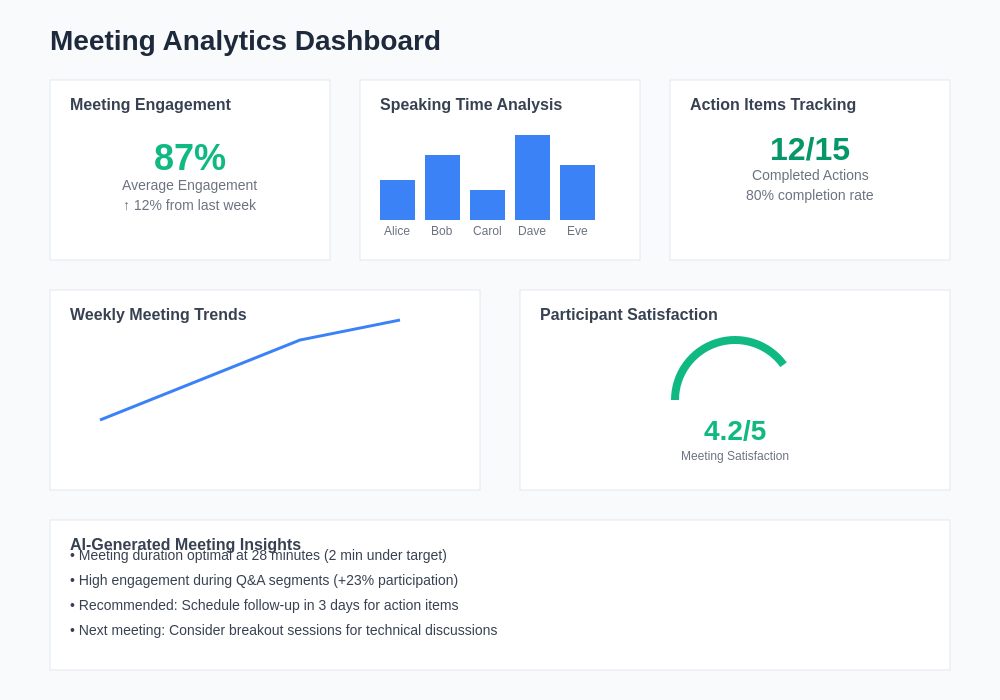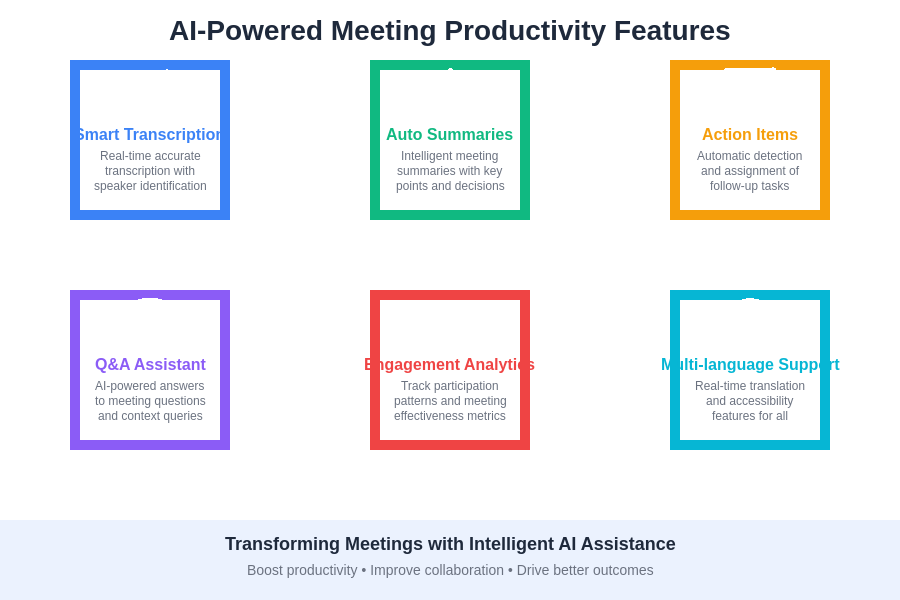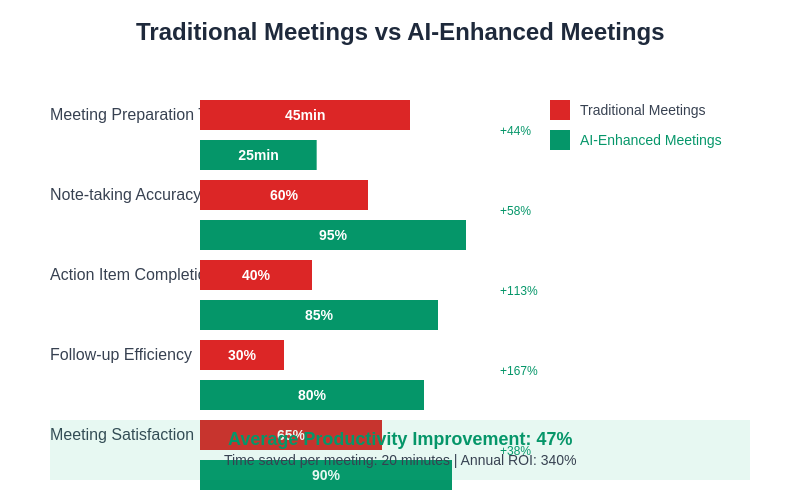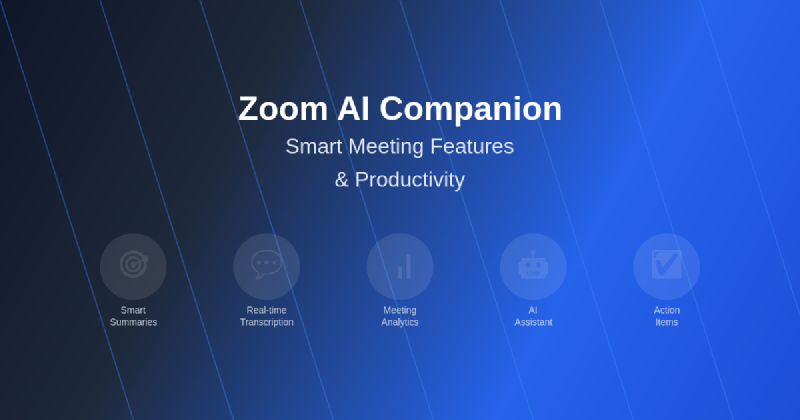The evolution of virtual communication has reached a transformative milestone with the introduction of Zoom AI Companion, a revolutionary suite of artificial intelligence features that fundamentally reimagines how we conduct, manage, and derive value from virtual meetings. This comprehensive AI-powered assistant represents a paradigm shift from passive video conferencing tools to intelligent collaborative platforms that actively enhance productivity, streamline communication, and unlock unprecedented insights from business interactions.
Explore the latest AI trends transforming workplace productivity to understand how artificial intelligence is reshaping professional communication and collaboration across industries. The integration of AI into meeting platforms represents more than technological advancement; it signifies a fundamental transformation in how organizations approach remote work, decision-making, and knowledge management in an increasingly digital business landscape.
Revolutionary Meeting Intelligence
Zoom AI Companion introduces an entirely new paradigm of meeting intelligence that transcends traditional video conferencing limitations by providing real-time analysis, automated insights, and proactive assistance throughout the entire meeting lifecycle. This sophisticated system leverages advanced natural language processing, machine learning algorithms, and contextual understanding to transform every meeting interaction into valuable business intelligence that drives organizational efficiency and strategic decision-making.
The platform’s intelligent capabilities extend far beyond simple transcription services, encompassing comprehensive meeting analytics, participant engagement tracking, sentiment analysis, and automated action item identification. This holistic approach to meeting intelligence ensures that no valuable insight is lost, every participant contribution is captured, and follow-up activities are systematically organized for maximum impact and accountability.
Automated Meeting Summaries and Transcription
The cornerstone of Zoom AI Companion’s value proposition lies in its sophisticated automated meeting summary and transcription capabilities, which eliminate the burden of manual note-taking while ensuring comprehensive documentation of all meeting proceedings. The system generates detailed, contextually accurate transcriptions in real-time, enabling participants to focus entirely on meaningful discussion and collaborative problem-solving rather than administrative documentation tasks.
These intelligent summaries go beyond simple verbatim transcription by identifying key discussion points, highlighting important decisions, extracting action items with assigned responsibilities, and organizing content into logical, searchable categories. The AI system’s ability to distinguish between casual conversation and critical business content ensures that summaries focus on the most valuable and actionable information, creating a reliable knowledge base that supports long-term organizational learning and reference.

The advanced analytics capabilities provide unprecedented visibility into meeting effectiveness, participant engagement patterns, and communication dynamics that enable organizations to optimize their collaborative processes and improve overall meeting ROI.
Smart Question and Answer Features
One of the most innovative aspects of Zoom AI Companion is its intelligent question and answer functionality, which serves as a real-time meeting assistant capable of providing instant responses to queries, clarifying complex topics, and offering relevant context from previous discussions or organizational knowledge bases. This feature transforms meetings from simple communication exchanges into dynamic, information-rich collaborative sessions where participants have immediate access to comprehensive background information and supporting data.
The system’s sophisticated natural language understanding enables it to interpret questions in context, provide relevant answers from multiple sources, and even suggest follow-up questions that might lead to deeper insights or more comprehensive solutions. This capability is particularly valuable for complex business discussions where multiple stakeholders need quick access to detailed information, historical context, or comparative analysis to make informed decisions.
Experience advanced AI capabilities with Claude for comprehensive meeting preparation, analysis, and follow-up activities that enhance the overall value of business communications. The integration of multiple AI systems creates a powerful ecosystem that supports every aspect of professional meeting management from initial planning through final implementation of discussed initiatives.
Enhanced Participant Engagement Tracking
Zoom AI Companion revolutionizes meeting management through sophisticated participant engagement tracking that provides detailed insights into communication patterns, contribution levels, and collaborative dynamics within virtual meetings. This advanced analytics capability enables meeting organizers and team leaders to identify engagement trends, recognize participation imbalances, and implement strategies to improve overall meeting effectiveness and inclusivity.
The system monitors various engagement indicators including speaking time distribution, question frequency, response patterns, and interaction quality to generate comprehensive engagement reports that help organizations understand how different team members contribute to discussions and decision-making processes. This data-driven approach to meeting analysis enables more effective facilitation, better resource allocation, and improved team dynamics through evidence-based insights rather than subjective observations.
Intelligent Action Item Management
The automated action item management feature represents a significant advancement in meeting follow-up and accountability systems, eliminating the common problem of forgotten commitments and unclear responsibilities that often plague traditional meeting processes. Zoom AI Companion automatically identifies actionable commitments made during discussions, assigns them to appropriate participants, and creates structured task lists with clear deadlines and deliverable expectations.
This intelligent system goes beyond simple task identification by analyzing the context of commitments, suggesting realistic timelines based on discussion complexity, and even recommending resources or additional stakeholders who might need to be involved in task completion. The integration with calendar systems and project management tools ensures that action items seamlessly flow into existing workflow processes, maintaining momentum and accountability long after meetings conclude.
Real-Time Language Translation and Accessibility
Zoom AI Companion breaks down communication barriers through advanced real-time language translation capabilities that enable seamless collaboration across global teams and diverse linguistic backgrounds. This feature supports dozens of languages with high accuracy translation that preserves context, tone, and meaning while enabling natural conversation flow between participants speaking different languages.
The accessibility features extend beyond translation to include real-time closed captioning, voice enhancement for participants with hearing difficulties, and customizable display options that accommodate various accessibility needs. These inclusive design elements ensure that AI-powered meeting enhancement benefits all team members regardless of their linguistic background, physical abilities, or technical comfort levels, creating truly equitable collaborative environments.
Advanced Meeting Analytics and Insights
The comprehensive analytics platform within Zoom AI Companion provides organizations with unprecedented visibility into meeting effectiveness, communication patterns, and collaborative outcomes through detailed performance metrics and trend analysis. These insights enable data-driven improvements to meeting processes, resource allocation decisions, and team development strategies based on objective measurement rather than subjective impressions.
The analytics dashboard presents information across multiple dimensions including meeting duration optimization, participant satisfaction metrics, decision-making efficiency, and follow-up completion rates. This multi-faceted approach to meeting analysis helps organizations identify best practices, recognize areas for improvement, and implement systematic enhancements that compound over time to create significant productivity gains and improved collaborative outcomes.

The comprehensive feature set demonstrates how AI integration transforms traditional video conferencing into intelligent collaboration platforms that actively contribute to business success through enhanced communication, improved decision-making, and streamlined workflow management.
Leverage advanced research capabilities with Perplexity to enhance meeting preparation and follow-up research that supports informed decision-making and comprehensive analysis of discussed topics and initiatives.
Personalized Meeting Experiences
Zoom AI Companion delivers highly personalized meeting experiences that adapt to individual participant preferences, role requirements, and communication styles to optimize engagement and productivity for each team member. The system learns from participant behavior patterns, meeting history, and stated preferences to customize interface elements, information presentation, and interaction options that align with personal working styles and professional responsibilities.
This personalization extends to content prioritization, where the AI system highlights information most relevant to each participant’s role and responsibilities while filtering less pertinent details to reduce cognitive load and improve focus. The adaptive interface ensures that executives receive high-level strategic summaries while technical team members access detailed implementation specifics, creating tailored experiences that maximize value for every participant regardless of their position or expertise level.
Integration with Productivity Ecosystems
The seamless integration capabilities of Zoom AI Companion with existing productivity ecosystems ensure that meeting insights and outcomes flow naturally into established workflow processes without requiring significant changes to existing business practices. The platform connects with popular project management tools, calendar applications, document management systems, and customer relationship management platforms to create a unified productivity environment where meeting outcomes drive actionable business results.
These integrations enable automatic population of project timelines with meeting-generated action items, synchronization of calendar events with follow-up activities, and distribution of meeting insights to relevant stakeholders who may not have attended the original discussion. This systematic approach to information flow ensures that valuable meeting outcomes contribute to broader organizational objectives rather than remaining isolated in meeting documentation that may never be revisited or acted upon.
Security and Privacy Considerations
Zoom AI Companion implements enterprise-grade security measures and privacy protections that ensure sensitive business information remains secure while enabling powerful AI analysis and insight generation. The platform employs advanced encryption protocols, access control mechanisms, and data governance frameworks that comply with international privacy regulations while maintaining the functionality and convenience that makes AI assistance valuable for business operations.
The security architecture includes options for on-premises processing of sensitive content, customizable data retention policies, and granular permission controls that enable organizations to balance AI capabilities with their specific security requirements and compliance obligations. This flexible approach to security ensures that organizations across different industries and regulatory environments can leverage AI meeting enhancement while maintaining appropriate protection of confidential information and intellectual property.
Collaborative Decision Making Enhancement
The AI-powered decision-making support features within Zoom AI Companion transform meetings from discussion forums into structured decision-making processes that systematically evaluate options, capture reasoning, and document outcomes for future reference and analysis. The system identifies decision points during discussions, summarizes different perspectives and arguments, and creates comprehensive decision records that include context, alternatives considered, and rationale for chosen approaches.
This structured approach to decision documentation creates valuable organizational knowledge that supports future strategic planning, helps avoid repeated discussions of previously resolved issues, and enables better decision-making through access to historical context and outcomes. The decision tracking capabilities also facilitate accountability by clearly documenting who made specific decisions and the reasoning behind those choices, creating transparency and learning opportunities that improve organizational decision-making over time.
Future-Ready Meeting Technology
Zoom AI Companion represents the foundation for future meeting technology evolution, with architectural design that supports continuous enhancement through machine learning advancement, integration expansion, and feature development based on user feedback and changing business needs. The platform’s modular design enables gradual adoption of new AI capabilities while maintaining stability and reliability of core meeting functions that organizations depend on for daily operations.
The forward-looking approach includes support for emerging technologies such as virtual reality integration, advanced biometric analysis, and predictive meeting optimization that will further enhance collaborative experiences as these technologies mature and become practical for business applications. This future-ready architecture ensures that organizations investing in AI-powered meeting technology will continue to benefit from innovation and improvement without requiring disruptive platform changes or significant additional investments.

The quantitative improvements in meeting effectiveness, participant satisfaction, and business outcomes demonstrate the substantial return on investment that organizations achieve through AI-powered meeting enhancement technologies.
Implementation Strategies and Best Practices
Successful implementation of Zoom AI Companion requires strategic planning that considers organizational culture, technical infrastructure, user training requirements, and change management processes to ensure smooth adoption and maximum value realization. Organizations should develop comprehensive implementation roadmaps that include pilot programs, gradual feature rollout, user feedback collection, and continuous optimization based on actual usage patterns and business outcomes.
The most effective implementation strategies focus on demonstrating immediate value through high-impact use cases while gradually expanding AI utilization as users become comfortable with the technology and begin to identify additional opportunities for enhancement. This approach builds confidence and enthusiasm for AI-powered meeting enhancement while avoiding overwhelming users with too many new features simultaneously, ensuring sustainable adoption and long-term success.
Measuring AI Meeting Enhancement Success
Organizations implementing Zoom AI Companion should establish comprehensive measurement frameworks that track both quantitative metrics and qualitative improvements to validate the business value of AI-powered meeting enhancement and identify opportunities for further optimization. Key performance indicators should include meeting efficiency improvements, action item completion rates, participant satisfaction scores, and business outcome acceleration to create a holistic view of AI impact on organizational productivity.
The measurement approach should also consider longer-term benefits such as improved decision-making quality, enhanced knowledge retention, better team collaboration, and reduced meeting fatigue that contribute to overall organizational effectiveness but may require extended observation periods to accurately assess. This comprehensive measurement strategy ensures that organizations can demonstrate clear return on investment while continuously optimizing their use of AI meeting technology for maximum business benefit.
Industry-Specific Applications and Benefits
Different industries and organizational types can leverage Zoom AI Companion capabilities in unique ways that align with their specific operational requirements, regulatory constraints, and business objectives to create customized meeting enhancement strategies. Healthcare organizations might focus on patient care coordination and compliance documentation, while financial services firms could emphasize security features and regulatory reporting capabilities that support their specialized operational requirements.
The flexibility of AI meeting enhancement enables organizations to tailor feature utilization and integration approaches to their unique business contexts while still benefiting from the core productivity and collaboration improvements that make AI-powered meeting technology valuable across diverse industry sectors. This adaptability ensures that organizations can achieve meaningful benefits regardless of their specific operational characteristics or industry requirements.
Disclaimer
This article is for informational purposes only and does not constitute professional advice regarding technology implementation or business strategy. The views expressed are based on current understanding of AI meeting technologies and their applications in business environments. Readers should conduct their own research and consider their specific requirements when evaluating AI-powered meeting enhancement solutions. The effectiveness of AI meeting features may vary depending on specific use cases, organizational context, and implementation approaches.
